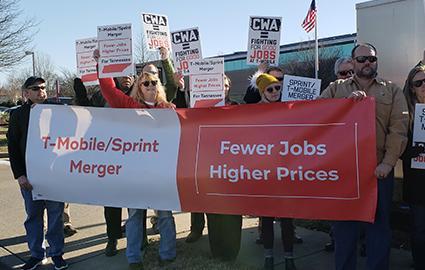Washington, D.C. - The Communications Workers of America (CWA) today announced that it had filed comments with the Federal Communications Commission (FCC) assessing February 21 and March 6 filings submitted by T-Mobile and Sprint on behalf of their proposed merger.
CWA’s new comments and accompanying analysis conclude that the companies “continue to fall far short of demonstrating that the proposed merger of T-Mobile and Sprint, as currently structured, is in the public interest. The harms of the proposed transaction are demonstrable and real, while the alleged benefits are speculative and uncertain.” The companies’ latest filings and related economic analysis include overstated claims regarding rural America, consumer benefits, and in-home broadband services.
Below find key excerpts and takeaways from CWA’s new filing with a full version available online here:
Companies’ “new network combination plan does not move the needle for rural America.”
CWA’s new filing and detailed analysis makes clear that the companies’ “new network combination plan” does not change the reality that for the great majority of rural America, the level of coverage and capacity would be similar for the post-merger “New T-Mobile” network and the standalone T-Mobile network if no merger occurs. The rural service offered by the merged company will not be materially different from what T-Mobile can do on its own. The companies’ latest filings fail to demonstrate merger-related benefits for the 84.6 million Americans (26 percent of the 325.5 million total population assumed by the Public Interest Statement) who would still lack New T-Mobile mid-band coverage in 2021, and the 45.9 million Americans (14 percent of the 328.1 million total population assumed by the Statement) who would continue to lack access to these high-capacity midbands in 2024. And the companies’ claims that the combination of Sprint’s mid-band spectrum with T-Mobile’s low-band spectrum will improve throughput and capacity does not apply to most of rural America, since Sprint’s mid-band spectrum is not well-suited to rural America. In summary, “the new network combination plan does not move the needle for rural America.”
T-Mobile and Sprint’s “eleventh hour submission of a new economic model that covers the 2019-2021 timeframe should be viewed very skeptically” and contradicts earlier statements by T-Mobile’s own chief technology officer.
In September 2018, T-Mobile’s Chief Technology Officer Neville Ray explained that the companies’ merger simulation engineering model did not include the years prior to 2021 “because the integration efforts would not be complete nationally until 2021 (assuming the transaction closes in 2019).” Yet the companies’ new economic analysis tries to put a good face on what is likely to happen during the three year period when T-Mobile plans to move millions of Sprint customers off of their network and onto T-Mobile’s network, if the merger goes through. As CWA’s filing details this should be viewed “very skeptically.”
Like “T-Mobile’s recent three year price freeze promise, the newly claimed consumer welfare benefits during the integration period only appear to have been “discovered” after the FCC raised questions about the competitive effects of the merger during that three year period. What’s more, the price freeze promise and the newly discovered efficiencies actually may be in tension … Ultimately, however, one does not have to be an economist to understand why the Applicants consciously decided not to try to quantify alleged near term marginal cost savings and quality improvements in their original merger simulation. The real answer is that these benefits, even if they could be quantified, would be small.”
FCC porting data “show plainly” that companies are each other’s primary competitor.
The companies continue to try to avoid recognizing how closely T-Mobile and Sprint compete with each other. They put forward an economic approach that is “likely to lead to results that would make consumers relatively insensitive to prices, and thereby to overestimate the benefits of the proposed merger.” Now their other group of economists adopt this approach in estimating “diversion ratios,” but the results are simply not credible. CWA suggests that the best way to evaluate customer switching and estimate diversion ratios is to use FCC porting data, which “show plainly that Sprint and T-Mobile are each other’s primary competitor.”
Finally, the companies’ in-home broadband claims are overstated.
The companies’ new filings regarding in-home broadband claims are neither new nor persuasive - the only thing new is “the amount of hype.” As CWA assesses, “the proposed in-home service is significantly technically inferior and less flexible than the broadband services with which it purportedly would compete and is focused on areas where broadband service already exists.” And even the companies’ overly optimistic projections for this unproven technology will only serve 9.5 million Americans by 2024 - most of whom are in metro areas and already have access to 2 or more competing brand providers.

